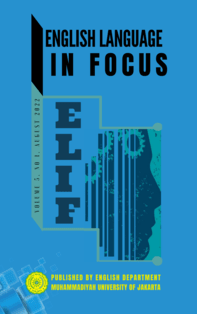Students’ Perception on the Digital Storytelling App in Learning Recount Text
DOI:
https://doi.org/10.24853/elif.5.1.11-18Abstract
Eighth grade students of SMPN 11 Tegal have already implemented digital storytelling in learning recount text. But the perception of learning is not yet known. therefore it is necessary to have research with the aim to describe the perceptions of eighth grade students on the use of digital storytelling in learning recount text in SMP N 11 Tegal. This research is a descriptive study with an approach quantitative. The method used is the survey method and cluster sampling method by randomly drawing lots. The research instrument used was a questionnaire with 19 statements. The research instrument trials were conducted on 20 eighth and eighth grade students of Tegal Middle School 11. Questionnaire is declared valid and reliable (r count = 0.444). The subjects were eighth E and eighth F grade students of Tegal Middle School with a total of 50 respondents. Data analysis techniques using descriptive statistical techniques in the form of descriptive and frequency distribution. Based on the results of the study showed that the perception of eighth grade students of SMPN 11 Tegal on learning recount text using digital storytelling was in the very positive category. This can be seen in the recount text variable as much as 67.6% (very positive), 29.2% (positive), 3.2% (negative), and no one has a very negative perception. In the digital storytelling variable as many as 67.66% (very positive), 32.67% (positive), 1.66% (negative), and no one had a very negative perception. On the variable speaking skills as much as 64% (very positive), 35% (positive), 1% (negative), and no one has a very negative perceptionReferences
Adiyanta, F. C. S. (2019). Hukum dan Studi Penelitian Empiris : Penggunaan Metode Survey sebagai Instrumen Penelitian Hukum Empiris. Adminitrative Law & Governance Journal., 2(4), 697–709.
Budiarso, I. (2017). Analisis Kemampuan Keterampilan Berbicara Bahasa Inggris terhadap Kinerja Karyawan PT Berrys Internasional Jakarta. JABE (Journal of Applied Business and Economic), 3(1), 1. https://doi.org/10.30998/jabe.v3i1.1752
Chigona, A. (2012). Pre-service students’ perceptions and experiences of digital storytelling in diverse classrooms. Turkish Online Journal of Educational Technology, 11(3), 278–285.
Husna, A., & Multazim, A. (2019). Students’ Difficulties in Writing Recount Text At Inclusion Classes. LET: Linguistics, Literature and English Teaching Journal, 9(1), 52. https://doi.org/10.18592/let.v9i1.3077
Idayani, A. (2019). THE EFFECTIVENESS OF DIGITAL STORYTELLING ON STUDENTS’ SPEAKING ABILITY. Jurnal Pendidikan, 10(1), 1689–1699. https://doi.org/10.1017/CBO9781107415324.004
Laina, P. N., & Marlina, L. (2018). Journal of English Language Teaching CREATING DIGITAL STORYTELLING TO IMPROVE EFL STUDENTS ’ N ARRATIVE WRITING AT SENIOR HIGH SCHOOL. 7(1).
Magdalena, I., Ishaq, A. R., Maemunah, S., & Wijaya, R. R. (n.d.). Kreativitas Guru Dalam Penggunaan Metode Pembelajaran PPKN di Kelas V SD Negeri Bojong 04 Tangerang. 2020, 2, 25–41.
Martaida, T., Bukit, N., & Ginting, E. M. (2017). The effect of discovery learning model on student’s critical thinking and cognitive ability in junior high school. IOSR Journal of Research & Method in Education (IOSR-JRME), 7(6), 1–8. https://doi.org/10.9790/7388-0706010108
Price, D. M., Strodtman, L., Brough, E., Lonn, S., & Luo, A. (2015). Digital storytelling. Nurse Educator, 40(2), 66–70. https://doi.org/10.1097/NNE.0000000000000094
Qiong, O. U. (2017). A Brief Introduction to Perception. Studies in Literature and Language, 15(4), 18–28. https://doi.org/10.3968/10055
Sudarsono, A. (2016). HUBUNGAN PERSEPSI TERHADAP KESEHATAN DENGAN KESADARAN (MINDFULNESS). Jurnal Ilmiah Psikkologi Terapan, 4(1), 10. https://doi.org/10.5151/cidi2017-060
Sulistianingsih, E. (2017). Efektifitas Model Pembelajaran Berbasis Dongeng Digital Untuk Meningkatkan Kecerdasan Emosi Peserta Didik. Jurnal Penelitian Pendidikan, 34(2), 121–126.
Taherdoost, H. (2018). Sampling Methods in Research Methodology; How to Choose a Sampling Technique for Research. International Journal of Academic Research in Management (IJARM), 5(September), 18–27. https://doi.org/10.2139/ssrn.3205035
Tanrıkulu, F. (2020). Students’ perceptions about the effects of collaborative digital storytelling on writing skills. Computer Assisted Language Learning, 0(0), 1–16. https://doi.org/10.1080/09588221.2020.1774611
Ummah, U. S., & Pambudy, A. P. (2017). Management of Inclusive Education Institutions ( A Case Study of an Inclusive Education Provider ’ s Primary School in Bandung and Sidoarjo City , Indonesia ). 4(3), 122–131. https://doi.org/10.23918/ijsses.v4i3p122
Widi, R. (2011). Uji Validitas Dan Reliabilitas Dalam Penelitian Epidemiologi Kedokteran Gigi. Stomatognatic (J.K.G. Unej), 8(1), 27–34.
Yanuarti, A. (2016). STUDENTS’ PERCEPTION TOWARD THE IMPLEMENTATION OF DIGITAL STORYTELLING IN TEACHING WRITING. Jurnal Ilmiah P2M STKIP Siliwangi P2M STKIP Siliwangi, 5(2), 1–6.
Yuniarti. (2017). DEVELOPING SPEAKING MATERIALS BASED ON THE COMMON EUROPEAN FRAMEWORK OF REFERENCE (CEFR) FOR INCREASING THE STUDENTS’ SPEAKING SKILL. Journal of Petrology, 3(1). https://doi.org/10.1017/CBO9781107415324.004
Published
Issue
Section
License
Authors who publish with this journal agree to the following terms:
- Authors retain copyright and grant the journal right of first publication with the work simultaneously licensed under a Creative Commons Attribution License that allows others to share the work with an acknowledgment of the work's authorship and initial publication in this journal.
- Authors can enter into separate, additional contractual arrangements for the non-exclusive distribution of the journal's published version of the work (e.g., post it to an institutional repository or publish it in a book), with an acknowledgment of its initial publication in this journal.
- Authors are permitted and encouraged to post their work online (e.g., in institutional repositories or on their website) before and during the submission process, as it can lead to productive exchanges, as well as earlier and greater citation of published work (See The Effect of Open Access).


